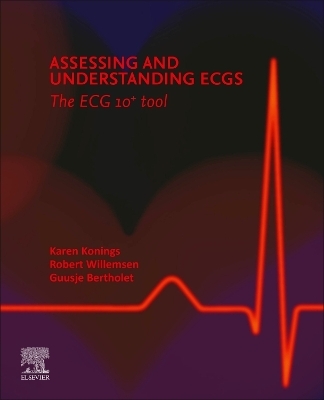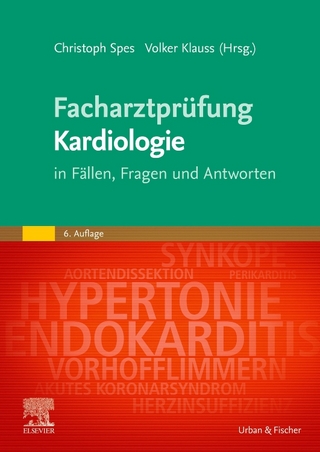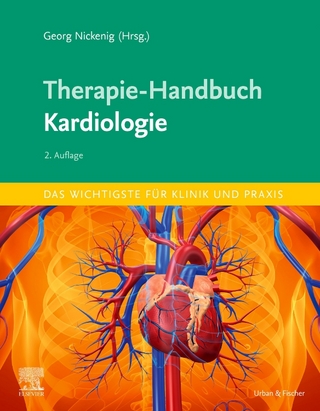
Assessing and Understanding ECGs: The ECG 10+ tool
Elsevier - Health Sciences Division (Verlag)
978-0-323-88080-0 (ISBN)
- Noch nicht erschienen (ca. Januar 2026)
- Versandkostenfrei innerhalb Deutschlands
- Auch auf Rechnung
- Verfügbarkeit in der Filiale vor Ort prüfen
- Artikel merken
The book presents a new method, ECG10+, for assessing ECGs without missing relevant pathology. The method enables readers systematically and safely to read ECGs by addressing 10 ECG findings and linking them to the clinical presentation. The book covers indications and quality of assessment, how to undertake ECGs, explanations of equipment and assessment of the various types of ECG waves.
Assessing and Understanding ECGs is ideal for GPs, nurses and other healthcare workers who may need to make or interpret ECGs, as well as residents and clinicians working in hospital settings both in and outside cardiology.
Logical and easy to follow - written in plain language for non-cardiology clinicians
Bespoke images specially created to support understanding
Unique and visually uniform translation from the heart function to the ECG-view enables the reader to thoroughly understand the ECG
Full explanation of the electrophysiological function of the heart and related PQRST-waves as seen on the 12-lead ECG ('from pump to paper')
Introduction and explanation of ECG10+ - a safe and systematic method to assess ECGs quickly and thoroughly
Simple checklist to facilitate ECG interpretation in daily practice
61 case studies describe highly relevant clinical ECG-related problems in out-of-hospital situations, for practising theory and the ECG10+ method
Summaries and reference chapter provide a concise overview
Section One (Textbook content)
Part 1 ECGs in primary care / outside the hospital setting - Indications and quality of assessment
1.1 ECGs outside the hospital setting
1.2 Patients with cardiac symptoms
1.2.1 Irregular heartbeat
1.2.2 Palpitations and tachycardia
1.2.3 Bradycardia
1.2.4 Chest pain
1.2.5 Suspected heart failure
1.2.6 A patient in the emergency room
1.2.7 ECGs in childhood
1.3 Screening in patients without complaints
1.3.1 Increased cardiovascular risk
1.3.2 Screening for atrial fibrillation
1.3.3 Screening after syncope
1.3.4 Screening upon starting QT-elongating medication
1.3.5 Pre-operative screening
1.3.6 Screening in sportspeople
1.3.7 Screening in family members of patients with sudden cardiac death
1.4 Quality of ECG assessment by non-cardiologists
1.5 Summary: indications of ECGs by non-cardiologists
Part 2 Making and understanding ECGs - basic electrophysiology and electrocardiography
2.1 Instructions for making ECGs
2.1.1 Electrodes and leads
2.1.2 Tips and tricks for high quality ECGs
2.1.3 ECG interpretation software
2.2 Explaing the ECG-waves
2.2.1 ECG-registration of heart activity
2.2.2 ECG-leads explained
2.2.3 ECG-paper: settings and definitions
2.2.4 Explaining P-, Q-, R-, S- and T-waves
Part 3 Assessing and understanding ECGs - systematic assessment using the ECG10+ method
3.1 Introduction ECG10+ checklist
3.2 ECG10+ checklist: systematics and explanation
3.2.1 ECG10+ point 1: frequency, regularity (and rhythm)
3.2.2 ECG10+ point 2: heart axis
3.2.3 ECG10+ point 3: P-wave
3.2.4 ECG10+ point 4: PQ-interval
3.2.5 ECG10+ point 5: Q-wave
3.2.5 ECG10+ point 6: QRS-complex (R-progression, height, width)
3.2.6 ECG10+ point 7: ST-interval
3.2.7 ECG10+ point 8: T-wave
3.2.8 ECG10+ point 9: QT-interval
3.2.10 ECG10+ point 10: Rhythm
3.2.11 ECG10+ point +: Diagnosis and plan
3.3 Keep it simple!
Part 4 Reference
4.1 Summary
4.2 Main illustrations in overview
Section Two Case studies: 31 cases (to be expanded to 50)
No complaints
1 Hypertension
2 Examination
3 Safely exercising
4 Sudden cardiac death in the family
5 Routine ECG
6 'Fun' ECG
Slow
7 Woman of high age
8 Unwell while swimming
9 Progressive exercise intolerancy
10 Fatigue
Fast
11 Palpitaions
12 Dizziness upon bending over
13 Dyspnea upon exercise
14 Agoraphobia
15 Working 80 hours a week
16 Chest pain upon exercise
Fast-summary
Palpitations
17 Missing beats
18 Frightened
19 Heart in the throat
20 Brady-tachy
Pain
21 Blessing in disguise
22 Sick
23 Irradiating pain
24 Oppressive pain
25 112-call
26 Coronary artery disease?
Chronic
27 Heart failure
28 Unknown history
29 Progressive complaints
30 Shortness of breath and ankle edema
31 A psychiatric patient
Appendices
Abbreviations
Literature
Index
| Erscheinungsdatum | 05.03.2024 |
|---|---|
| Verlagsort | Philadelphia |
| Sprache | englisch |
| Maße | 191 x 235 mm |
| Themenwelt | Medizinische Fachgebiete ► Innere Medizin ► Kardiologie / Angiologie |
| Studium ► 1. Studienabschnitt (Vorklinik) ► Physiologie | |
| ISBN-10 | 0-323-88080-0 / 0323880800 |
| ISBN-13 | 978-0-323-88080-0 / 9780323880800 |
| Zustand | Neuware |
| Haben Sie eine Frage zum Produkt? |
aus dem Bereich


